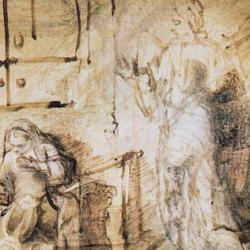Back to Witherington, and I discern that nuance and subtlety are not Witherington’s style, at least not in these posts. He writes, “Gen. 3.15 is not in any way shape or form a messianic prophecy about a warrior messiah. The ‘he’ in question is the descendants of Eve of course and in any case, even if it were a reference to Christ, Christ solved the Satan problem not by being a warrior messiah and thus by killing but by dying on a cross!! Jesus was the antithesis of a warrior messiah when he came.” Emphasis added, though it hardly needed to be.
To his first point, it is hard to know what to say. Witherington and I read the Bible in such radically different ways that debating particular passages seems almost pointless. The difference perhaps boils down to the basic question of whether the Bible should be read as a unified book. If it is, then it’s perfectly natural that the hero of the story should be introduced under a veil early on. It seems that Witherington reads the Bible as a collection of more or less discrete texts.
I take it that Witherington’s plural “descendants of Eve” is deliberate, and I can agree to some extent: In the New Testament, Satan is trampled under the feet of the saints (Romans 16:20). But that is because the plural collective seed of the woman is united with the singular Seed that is Christ, thus forming one Christ, the one seed (Galatians 3). If Witherington has Abel in mind, I can agree with that too, provided we take Hebrews seriously that Abel is a type of Jesus the Seed. Any way you slice it, you can’t get Jesus out of the passage, and I’m baffled that Witherington would want to try.
On the plus side, I will only say that my Christological interpretation of Genesis 3:15, as I’m sure Witherington knows, is a common pre-modern interpretation of the passage:
Irenaeus, Against Heresies , Book 5: Christ “has . . . in His work of recapitulation, summed up all things, both waging war against our enemy and crushing him who had at the beginning led us away captives in Adam, and trampled upon his head, as you can perceive in Genesis that God said to the serpent” – this followed by a quotation of Genesis 3:15.
Irenaeus, Against Heresies , Book 3: “He put enmity between the serpent and the woman and her seed, they keeping it up mutually: He, the sole of whose foot should be bitten, having power also to tread upon the enemy’s head; but the other biting, killing, and impeding the steps of man, until the seed did come appointed to tread down his head—which was born of Mary.”
Leo the Great, Sermon 22 : God “foretold at the very beginning of the world the remedy His piety had prepared for the restoration of us mortals: proclaiming to the serpent that the seed of the woman should come to crush the lifting of his baneful head by its power, signifying no doubt that Christ would come in the flesh, God and man, who born of a Virgin should by His uncorrupt birth condemn the despoiler of human stock.”
Gregory Thaumaturgus, On All the Saints : “In olden time Jacob beheld a ladder erected reaching to heaven, and the angels of God ascending and descending upon it. But now, having been made man for man’s sake, He who is the Friend of man has crushed with the foot of His divinity him who is the enemy of man, and has borne up the man with the hand of His Christhood, and has made the trackless ether to be trodden by the feet of man.”
Cyprian, Treatise 12, Book 2 : After quoting Isaiah 7, he writes, “This seed God had foretold would proceed from the woman that should trample on the head of the devil.”
Ephraim, Hymn 38 : “Satan came in, against Whom, had been proclaimed seven woes even against him; though mightily the Son of Mary had trodden on him, yet uplifted is his spirit; for he is the serpent that strives though bruised. Better is it for me to fall and worship, before this Jesus Who has conquered me by His Cross.”
These readings, it may be objected, ignore the immediate context, and there’s some truth to that. Still, so long as we read on the assumption that the Bible is one book, the patristic reading is defensible. Many, perhaps most modern commentators resist reading Christian meaning into Genesis 3, but a nuanced contextual Christological view is still represented and defended. Waltke sees Christ as the climax of a series of holy seeds: “The immediate seed is Abel, then Seth. The collective seed is the holy offspring of the patriarchs . . . After Genesis we do not hear again of the promised seed until God promises David a seed . . . , which should be interpreted in all three ways. The unique fulfillment of this seed promise, Jesus Christ, comes into the world through the seed of the woman.”
TD Alexander ( TynBul 1998) offers a similar reading, setting Genesis 3:15 in a trajectory of hope for a royal deliverer that stretches from Genesis to Kings: “The Abraham narrative builds on the divine promise given in Genesis 3:15 regarding the ‘seed of the woman’ overcoming the ‘seed of the serpent’. The motif of blessing which is very prominent in Genesis 12:1-3 stands in marked contrast to that of cursing which dominates the divine judgements announced in Genesis 3. In addition, within the Abraham narrative there are indications that the line of seed will give rise to royal descendants.” He argues, “While the Genesis-Kings narrative does not directly ascribe to the divinely-promised royal saviour the title of messiah, there can be little doubt that the New Testament concept of messiah is rooted in the traditions reflected in this material. While twentieth century Old Testament scholarship has generally reacted strongly against finding messianic ideology within the books of Genesis to Kings, we have observed the viability of doing otherwise.” He concludes with the comment that “by noting the centrality of ‘royal expectations’ in Genesis to Kings, we are in a much better position to understand how the Old Testament functions as a witness to Christ.”
Walter Wifall ( CBQ 1974) uncovers Davidic and hence messianic features in Genesis 3: “Many contemporary Biblical scholars have denied any ‘messianic’ significance to Gen 3:15. Yet, as valuable as their studies have been, the royal and ‘Davidic’ significance of this passage for both the OT and NT cannot be overlooked. Apparently, Gen 3:15 owes its present form to the Yahwist’s adaptation of both the David story (2 Sam-1 Kgs 2) and ancient Near Eastern royal mythology to Israel’s covenant faith and history. The Yahwist has thus presented Israel’s history and pre-history within a ‘Davidic’ or ‘messianic’ framework.” He argues that “the NT also portrays the messianic role and significance of Jesus in similar terms. Thus, Jesus is described as the ‘Christ’ or ‘Messiah’ descended from the ‘seed’ of David (Rom 1:3; 2 Tim 2:8). Although Paul traces Jesus’ background as the final ‘seed’ and fulfillment of the OT promises primarily back to Abraham (Gal 3:16), perhaps a glimpse also remains of the ‘messianic’ significance of Gen 3:15 in God’s sending a Son ‘born of a woman’ (Gal 4:4).”
Here’s an interesting example: “The woman is promised that her union with her husband will produce an heir who, in the end, will slay the one who deceived her (Gen. 3:15). Even in her fallen state, it is Eve who will bring forth the Christ. That’s from Sandra Richter, who used to teach OT at Asbury, Witherington’s own institution. Too bad she’s moved
on, because otherwise Witherington could take a stroll down the hall and see what Prof. Richter has to say for herself.
A common evangelical argument (mounted, e.g., by John Walton) against reading Genesis 3:15 Christologically is that the New Testament never explicitly identifies this passage as a typological one. That’s a rather narrow reading of both the passage and a constricted hermeneutical principle. Waltke’s and Alexander’s comments go some way to addressing that problem: “Seed” is a theme of the Old Testament, stretching and growing (like a seed!) as time goes on. When Abraham is promised a “seed,” that echoes back, in Genesis, to the promise of Genesis 3:15; and when David is promised a “seed,” that echoes back to the patriarchs and beyond that, once again, to Eden; and when the prophets say that the land will again be sowed with the seed of man, they are promising a renewed Davidic kingdom, a revival of the Abrahamic people, a fulfillment of the promise to Adam and Eve. When Christ is identified as the Seed (John 7:42; Romans 1:3; Galatians 3:16, 19 – following Wright, I take this as a collective Christ; Galatians 3:29 – note link of belonging to Christ and being Abraham’s seed; 2 Timothy 2:8), this entire OT story-line is in the background.
This line of interpretation is stronger if Jack Collins ( TynBul 1997) is right in arguing that the syntax of Genesis 3:15 indicates that zera is an individual rather than a collective “seed.” Collins argues that the closest syntactical parallel to Genesis 3:15 is 2 Samuel 7:13, where David is promised a singular “seed” to sit on his throne. That suggests that the repeated identifications of Jesus as “seed of David” in the New Testament reverberate all the way back to Genesis 3. Though Collins doesn’t take a position on whether Genesis 3:15 is a Messianic prophecy, he notes that the advancing narrative of Genesis points past Adam and Eve’s own children toward a future seed: “in Genesis 4:25 the woman calls her son Seth . . . ‘another seed [descendant]’ in place of the one slain. That is, she recognises that neither Cain nor Abel could be the ‘seed’ of 3:15: Cain because of his banishment from the Lord’s presence (4:16), and Abel because of his premature death. The author (or final editor) of Genesis develops this line still further, identifying the ‘seed’ not with Seth, but with a descendant of Seth, by way of Abraham and Judah (49:10).”
Though it doesn’t count as a proof text, it’s difficult to avoid reading Revelation 12 in the light of Genesis 2-3. The whole cast is reassembled: Woman, child, serpent. The child is clearly Christ Jesus, and he overthrows the serpent and casts him down from heaven to earth. He is victorious, and the saints are also victorious over the serpent through blood of the Lamb and the word of their testimony. Collins connects this passage with Genesis 3:15: “Under the interpretation [of Genesis 3:15] advanced here, this highly symbolic passage [Revelation 12] would represent the Messiah (the woman’s child) as the (primary) seed, and his followers as ‘seed’ by virtue of their relation to him.” True, the verb “crush” or “bruise” is absent; true, the dragon is not said to receive a head wound. But, c’mon!!, the passage is clearly about the seed of the woman triumphing over the serpent. It is substantively a fulfillment of Genesis 3:15, and it is about Jesus.
Witherington’s question about whether or what sort of messianic warrior Jesus was is more weighty, and I’ll need to devote a separate post to that.











